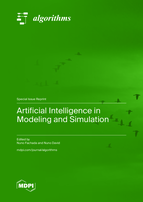Artificial Intelligence in Modeling and Simulation
A special issue of Algorithms (ISSN 1999-4893). This special issue belongs to the section "Combinatorial Optimization, Graph, and Network Algorithms".
Deadline for manuscript submissions: closed (31 March 2024) | Viewed by 71285
Special Issue Editors
Interests: computer science; machine learning; artificial intelligence; modeling and simulation; high performance computing
Special Issues, Collections and Topics in MDPI journals
Interests: simulation; agent-based models; computer ethics; privacy and data protection; philosophy of technology; data science
Special Issues, Collections and Topics in MDPI journals
Special Issue Information
Dear Colleagues,
Modeling and simulation (M&S), through continuous, discrete-event, agent-based, among other approaches, aims to describe different aspects of a real system. It avoids actual experimentation, which can be costly, time-consuming, or even impossible, as in the case of inaccessible systems, systems with uncontrollable factors, or systems which are still being designed. M&S is therefore a crucial component in engineering and in many scientific fields, such as physics, social science, medicine, defense, transport, chemistry, ecology or biology.
Artificial intelligence (AI) can be thought of as intelligence displayed by artificial systems capable of understanding their environment and performing tasks in order to achieve their goals. Following the widespread adoption of AI in academia and industry in recent years, M&S has also welcomed AI, embedding it into the simulation models themselves, using AI in their development, or both. When AI is present in a real system (e.g., transports, factories, social networks), the respective model needs to include AI as well. In other scenarios, models need to mimic natural intelligence, relying on AI techniques for doing so. AI and machine learning techniques enable the intelligent optimization and fine-tuning of simulation models, for example by training models with real system data or by effectively synchronizing models with live data, fostering both model verification and validation. These techniques also open the door to the efficient generation of metamodels, which can predict model responses for a number of parameter combinations without simulation. Metamodels bring about extraordinary accelerations in model optimization, especially in scenarios where models have many parameters and exploring their factor space is unfeasible due to long simulation times, as in the case of agent-based or multiscale models. Conversely, by generating simulated data, simulation models can train AI systems to be deployed in the real world.
This Special Issue aims to investigate the relationship between AI and M&S from perspectives such as: 1) the use of AI techniques, such as machine learning and computational intelligence algorithms, in applications of M&S to different systems; 2) the use of AI for implementing and optimizing simulation models, with special focus on verification and validation; 3) AI-driven creation of metamodels from agent-based and other computationally costly models; and 4) how simulation models or model-generated synthetic data drive machine learning.
We invite researchers to submit papers on the topic, from all viewpoints, including theoretical issues, algorithms, and systems, as well as academic and industrial applications in all areas of knowledge.
Dr. Nuno Fachada
Dr. Nuno David
Guest Editors
Manuscript Submission Information
Manuscripts should be submitted online at www.mdpi.com by registering and logging in to this website. Once you are registered, click here to go to the submission form. Manuscripts can be submitted until the deadline. All submissions that pass pre-check are peer-reviewed. Accepted papers will be published continuously in the journal (as soon as accepted) and will be listed together on the special issue website. Research articles, review articles as well as short communications are invited. For planned papers, a title and short abstract (about 100 words) can be sent to the Editorial Office for announcement on this website.
Submitted manuscripts should not have been published previously, nor be under consideration for publication elsewhere (except conference proceedings papers). All manuscripts are thoroughly refereed through a single-blind peer-review process. A guide for authors and other relevant information for submission of manuscripts is available on the Instructions for Authors page. Algorithms is an international peer-reviewed open access monthly journal published by MDPI.
Please visit the Instructions for Authors page before submitting a manuscript. The Article Processing Charge (APC) for publication in this open access journal is 1800 CHF (Swiss Francs). Submitted papers should be well formatted and use good English. Authors may use MDPI's English editing service prior to publication or during author revisions.
Keywords
- modeling and simulation
- artificial intelligence
- machine learning
- verification and validation
- metamodeling
Benefits of Publishing in a Special Issue
- Ease of navigation: Grouping papers by topic helps scholars navigate broad scope journals more efficiently.
- Greater discoverability: Special Issues support the reach and impact of scientific research. Articles in Special Issues are more discoverable and cited more frequently.
- Expansion of research network: Special Issues facilitate connections among authors, fostering scientific collaborations.
- External promotion: Articles in Special Issues are often promoted through the journal's social media, increasing their visibility.
- Reprint: MDPI Books provides the opportunity to republish successful Special Issues in book format, both online and in print.
Further information on MDPI's Special Issue policies can be found here.







